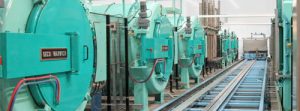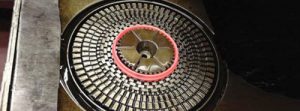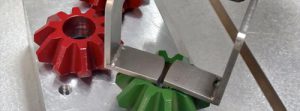Understanding the Jominy end quench test
The Jominy end quench test (ASTM A255 ) is an extremely simple and useful test that is applicable to many materials besides steel...
Use of molten salt in heat treatment
At the turn of the 20th century, the use of molten salt as a heating and quenching medium for steels was developed in England....
Heat treatment of aluminum VI – Artificial aging
In the previous column, we described the fundamentals of natural aging. In natural aging, the solid solution obtained after quenching starts to form precipitates...
An overview of refractory ceramic fibers
This article will review refractory ceramic fibers (RCFs), which are amorphous, inorganic, man-made aluminosilicate fibers. RCFs belong to a class of materials termed man-made...
Carbon Diffusion and Carburizing Parameter Selection
Although carburizing is a complicated process, it can be broken down into two main steps: carbon generation in the furnace and carbon diffusion into...
Case Depth Determination
Methodology to ensure design intent is satisfied
A technical guide to quenching
From a quality perspective, verification of the conformance of quench requirements can be accomplished by examining a furnace chart that shows the quench trend....
Using water as a quenchant
In this short column, we will discuss quenching with water. As a quenching medium, plain water approaches the maximum cooling rate attainable in a...
Determining austenite grain size
Grain size is a critical metallurgical characteristic, significantly influencing design parameters such as strength and toughness. Austenite grain size (often referred to as prior-austenite...
Carburizing
While some heat treatments are used to soften the material or improve its machinability, most are processed to obtain strengthened or hardened properties. The...
Heat treatment of aluminum – Part II
In my article last month, I discussed the alloying elements used in aluminum alloys. In this article, I will be discussing the solution heat...
An overview of insulating firebricks
Ceramic refractory materials are useful for the following functions:
1. Serving as a thermal barrier between a hot medium and the wall of a...
Retained austenite significant for strength, toughness
The role of retained austenite (RA) and the magnitude of its influence on the performance of steel components are continually debated. Depending on the...
Understanding the effect of boron in steels
In this column, we will discuss the effect of boron additions to steel and its influence on properties.
Boron, B, is an element with an...
Heat treatment of aluminum, part II: Water quenching
In the last article, we talked about the metallurgy behind quenching aluminum. Now we are going to discuss the available quenchants for aluminum.
Introduction
To achieve...
Hardening depth measurement
Surface hardening heat treatments are popular in the manufacture of steel products as a means of significantly improving strength and fatigue resistance and mitigating...
Heat treatment of aluminum – Part I: Quenching basics
In previous articles, we discussed the role of alloying elements and discussed the solution heat treatment of aluminum. We showed that it is important...
Performing a Temperature Uniformity Survey
Performing a temperature uniformity survey (TUS) can be somewhat of a daunting process. After all, a TUS carries the weight of not only being...
The mechanism of creep and its stages
In this column, I will discuss the mechanism of creep and its three stages.
Applications of metals at elevated temperatures involve several problems. It is...
Non-Martensitic Transformation Products (NMTP)
Whether formed during a conventional quench and tempering process, carburizing, or induction hardening, non-martensitic transformation products (NMTP) are widely considered undesirable microstructural features. However,...
How to keep decarburization in check
The performance of heat-treated steel components is largely dependent on the condition of their surface. Wear and fatigue resistance are examples of design criteria...
Heat treatment of aluminum, Part V
After quenching and any straightening, the supersaturated solid solution of aluminum wants to reach equilibrium. It does this through the process of precipitation hardening....
Microstructural evolution, its effect on Ti6Al4V alloy
Titanium alloys are extensively used in aerospace, petrochemical, marine, and medical applications, thanks to their superior strength-to-weight ratio at elevated temperature, corrosion resistance, and...
Carbon potential verification
Choose from several verification methods for best fit, then develop a plan to correct for out-of-spec test results
Materials Selection for Induction Hardening Processes
Induction hardening is the most common technique of the various types of applied energy processing. It uses alternating current that induces a magnetic field...
ASTM E18 and Nadcap: Rockwell hardness testing
Rockwell hardness testing is a common way to ensure the material response to heat treat is conforming and is required by applicable industry and...
Troubleshooting induction hardening problems: Part 1
Induction hardening is a unique method used to harden steels. The process uses a power supply, RF generator, induction coil, and quenching mechanism (spray...
Hardness scale conversion
The use of hardness testing as a quality control method to check the outcome of a thermal treatment process is a common application of...
Residual stress evaluation in bearings
Lingering stress is not easily identified during production, but has a direct impact on wear performance and fatigue life
Heat treatment of aluminum Part VII – Hardness and conductivity
In the previous article, we discussed the artificial aging of aluminum. Once we have heat treated the parts, we need to verify the properties....
AMS2750F contains key pyrometric changes
By now, most heat treaters should have had some time to read the new revision of AMS2750. The changes are extensive and, since it...
The heat treatment of aluminum – Introduction
Aluminum’s many desirable properties, such as high strength-to-weight ratio, good corrosion resistance, ease of processing, and low cost, make it a very widely used...
Carbon: Essential element or too much of a good thing
52100: Simple, yet it embraces carbon’s two-way benefit to steel
Classifying non-metallic inclusions in steels
In this column, we will discuss the different types of inclusions present in steels and discuss their physical metallurgy. As property requirements increase, and...
Furnace Doors
No matter the configuration, single or multi-chamber vacuum, batch integral quench, continuous, or even pits — an item that all furnaces have in common...
Determining Grossman H-value from cooling curve data
In the last article, I described how the Jominy end quench test could be used to predict hardness for a series of different round...
Heat treating is not for the faint of heart
Why heat-treating furnaces look the way they do, Part 2
Determining Austenite Grain Size
Grain size is a critical metallurgical characteristic, significantly influencing design parameters such as strength and toughness. Austenite grain size (often referenced to as prior-austenite...
Different Scales Are Used For Rockwell Hardness Testing
Production Bench Rockwell Hardness Testing of Small Work Pieces
As induction hardened workpieces get smaller in size, attention to the proper abrasive cutting of the...
Distortion during heating
Minimizing distortion involves more than just optimizing cooling






































